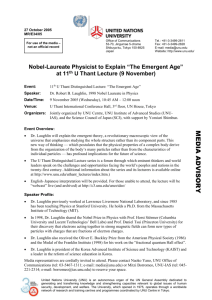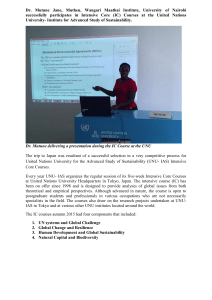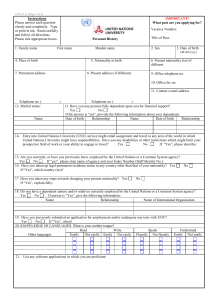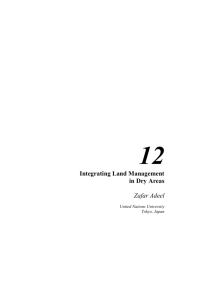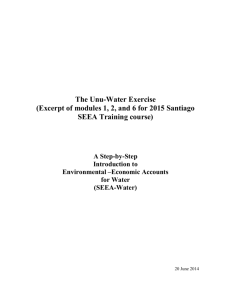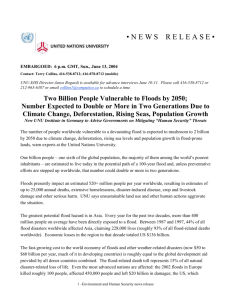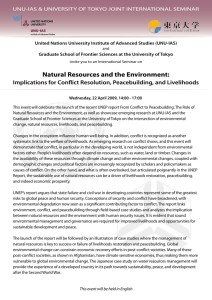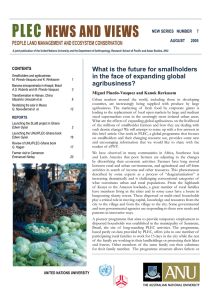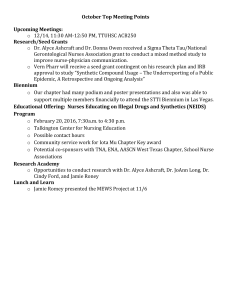Environmental Review 2006 January 2006
advertisement
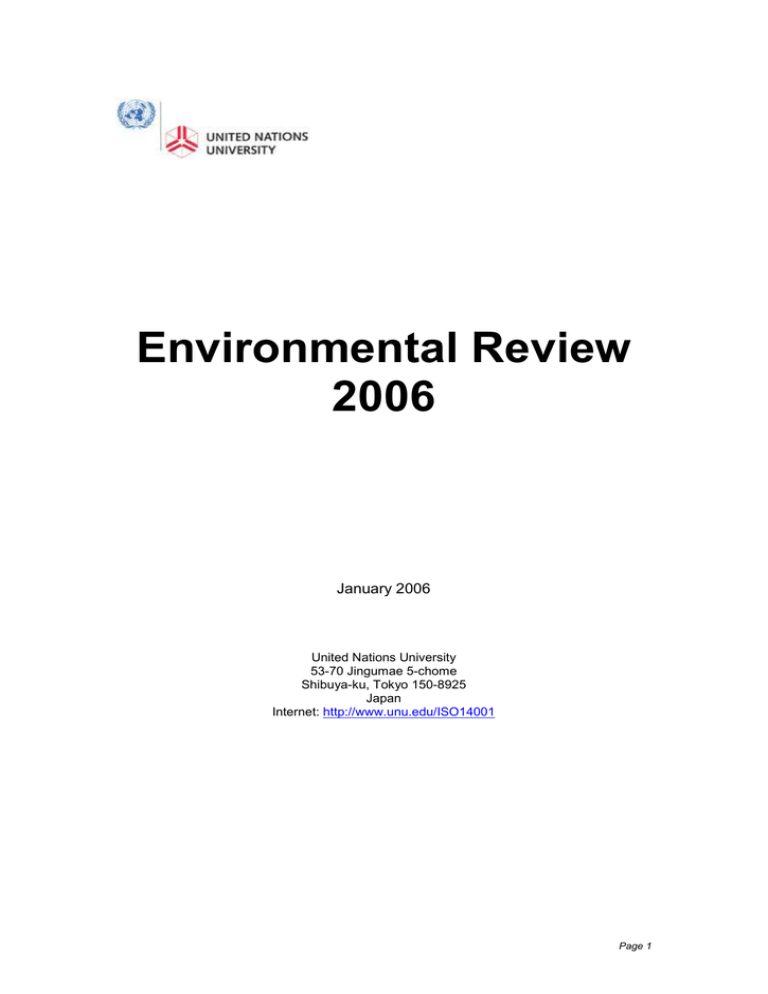
Environmental Review 2006 January 2006 United Nations University 53-70 Jingumae 5-chome Shibuya-ku, Tokyo 150-8925 Japan Internet: http://www.unu.edu/ISO14001 Page 1 Executive Summary This report presents a brief overview of the environmental performance of the United Nations University Centre (UNU Centre) and the Institute for Advanced Studies (UNU- IAS), in Tokyo and Yokohama respectively. Also included is an evaluation of the activities of the UNU Centre and UNU-IAS against the established environmental management system’s targets and objectives of the 2004-05 biennium. In the 2004-05 UNU fell short of meeting targets relating to the greening of UNU work practices, particularly in terms of reduction gas and electricity consumption and waste generation at the UNU Centre, but met the target for reductions in water/sewage. There was, however, a corresponding increase in the number of public events held in the last biennium, which would have a significant effect on utilities consumption and waste generation at the UNU Centre. There will need to be a stronger focus on improving the environmental performance of events at the UNU Centre. UNU continued to demonstrate a commitment towards environment related research and capacity building through the projects and initiatives associated with the Environment and Sustainable Development Programme of the UNU Centre and the research streams of the UNU-IAS, despite a prioritisation of research projects in the 2004-05 biennium. This continuation of research in environment was evidenced by the number of publications, journal articles, editorials, policy briefs, and discussion papers, as well as within capacity building efforts for fellowships, interns and training courses. Despite a slight decrease in UNU personnel at the UNU Centre and UNU-IAS the tenants at the UNU Centre (Unit 5: tenants) had fully occupied the total floor space of the building with the addition of the Universal Networking Digital Language Foundation in 2005. In 2004 UNU-IAS also relocated to Yokohama. The UNU is committed to making further environmental performance improvements in the 2006-07 biennium and will look to all areas of its activities and set clear priorities for action. Page 1 1 Introduction Research and capacity development work of the United Nations University (UNU) explores the interactions between human activities and the natural environment and their implications for the sustainable management of natural resources at the local, national, regional and global levels. The UNU is committed to the promotion of innovative solutions to pressing global environmental problems. We work in partnership with other UN agencies, national governments, academic institutions, nongovernment organizations, business and others to pursue this objective. Our specialists located in research and training centres across the globe have a long and successful track record of producing timely and targeted research designed to meet the needs of policy makers, particularly those from developing countries. The UNU is determined to establish strong credentials as an environmentally friendly institution. Today, the only effective way to establish these “green” qualifications is through the international environmental management standard – ISO14001. Consequently, in May 1999, the UNU set up a steering group under the guidance of the Environmental Co-ordinator (the then Vice Rector, Professor Motoyuki Suzuki) to develop an ISO14001 certified environmental management system that would reduce the impact on the environment through a process of continuous improvement. In January 2001 the UNU Centre and UNU-IAS were ISO14001 certified. In March 2004 this certification was renewed. In order to promote increased environmental awareness within the UNU, the University established an environmental policy under the banner “Going for Green”, as presented in Figure 1 (right). The following DRAFT report presents the findings of the third review of the UNU’s environmental performance. Previous Environmental Review reports are available from the UNU’s ISO14001 website (http://www.unu.edu/ISO14001). Figure 1 UNU Environmental Policy The United Nations University is committed to the ideals and practices of environmental sustainability and has established four goals for the continual improvement of the University’s environmental performance and for the prevention of pollution. We consider that these goals are appropriate to the nature, scale and environmental impacts of the University. 1. Greening Our Work Practices Comply with all applicable environmental laws and regulations, and with other requirements to which the UNU subscribes; Include environmental considerations in the University’s procurement practices; Reuse, reduce and recycle materials and goods purchased; and Save energy and reduce water consumption. 2. Greening Our Work Place Improve the quality of the working environment within the UNU buildings in Tokyo (internal air quality, drinking water quality, waste, lighting, health and safety, etc.) 3. Contribute to the Global Community Engage in research, networking, knowledge transfer and capacity building projects contributing to environmental sustainability 4. Contribute to the Local Community Participate as a responsible neighbour in local initiatives to improve the quality of the environment Organize events (such as World Environment Day) to raise local awareness of environmental problems Management and personnel of the UNU are expected to understand how their actions impact on the environment and to take measures to improve both environmental performance and quality so as to minimize the direct and indirect negative impacts of our activities, where ever possible. We will also highlight the positive contribution made by the University to the solution of pressing environmental problems around the world. The goals set out in this policy statement will be implemented through a comprehensive plan containing objectives and measurable targets and with monitoring, review, self-assessment and analysis of performance against the plan. We will also take corrective action, whenever appropriate, and encourage all personnel to participate in an open dialogue on how best to improve the environmental performance and environmental management system of the University. Page 2 2 Environmental Performance The following provides a summary of the environmental performance of the direct and indirect aspects at the UNU Centre and UNUIAS over the last biennium. The performance of direct aspects in terms of utilities consumption and waste and recycling is provided only for the UNU Centre. Data on direct impacts is unavailable for UNU-IAS because of the leasing constraints in the new office facilities in Yokohama. Over the last few years, there have also been significant changes in the number of employees in the UNU Centre and UNU-IAS and an increase in events at the UNU Centre such as conferences, workshops, seminars, public lectures that has assisted the reporting of a more balance environmental review. 2.2 cooling system) between 2002 and 2005, a marginal increase in electricity consumption, a decrease in water consumption and a marginal increase in expenditure for the biennium. Figure 4 (below) shows the annual electricity consumption per employee at UNU Centre between 1998 and 2005. Over the last biennium there was a marginal increase of 2%. In 2004 the total electricity consumption per employee was 18,836 kwh, which was a marginal increase of 388 kwh (or just over 2.0%) in comparison with 2003. In 2005 there was a marginal decrease of 83 kwh (or more than 0.4%) to a total of 18,754 kwh. Figure 4. Annual Electricity Consumption per Employee at UNU Centre Utilities Figure 2 (below) provides a summary of the annual consumption of electricity, gas and water between 1998 and 2005. In general utilities consumption, over the last biennium, has increased for electricity consumption (+6.1%) and significantly increased for gas consumption (+38.7%), but decreased for water consumption (-6.9%). Figure 2. Annual Utilities Consumption at UNU Centre Year 1998 1999 2000 2001 2002 2003 2004 2005 2004-05 biennium Electricity kwh 1,944,600 2,052,144 1,908,300 1,944,072 2,077,995 2,103,176 2,260,375 2,231,703 Gas m3 138,467 126,062 124,634 129,523 106,911 131,582 183,766 182,472 Water m3 6,423 8,546 6,128 6,685 6,564 10,223 9,032 9,520 +6.1% +38.7% -6.9% Figure 5 (below) shows annual gas consumption per employee at UNU Centre between 1998 and 2005. Over the last biennium there was an increase of almost 33%. In 2004 the total gas consumption per employee was 1,531 m3, which was a significant increase of 377 m3 (or almost 33%) in comparison with 2003. In 2005 there was a marginal increase of 2 m3 (or more than 0.1%) to a total of 1,533 m3. Figure 5. Annual Gas Consumption per Employee at UNU Centre Figure 3 (right) shows the utilities consumption and expenditure per employee relative to 1998 levels when the UNU first undertook the ISO14001 initiative. Figure 3. Index of Annual Utilities Consumption per Employee at UNU Centre 120 Index 100 Ele ctricity Gas Water ´ 80 60 Figure 6 (next page) shows the annual water consumption per employee at UNU Centre between 1998 and 2005. Over the last biennium there was a decrease of almost 11%. In 2004 the total water consumption per employee was 75 m3, a significant decrease of 14 m3 (or above 16%) in comparison with 2003. In 2005 there was an increase of 5 m3 (or 6%) to a total of 80 m3. 40 19 98 19 99 20 00 20 01 20 02 20 03 20 04 20 05 Figure 6. Annual Water Consumption per Employee at UNU Centre In terms of consumption per employee at the UNU Centre there was a significant increase in gas consumption (used for the heating and Page 3 Figure 9. Index of Annual Waste Disposal per Employee at UNU Centre 200 Index 150 Re cyclable Com bus tible 100 Non-Com bus tible Expe nditure 50 0 19 99 Figure 7 (below) shows the annual utilities expenditure per employee at UNU Centre between 1998 and 2005. Over the last biennium there was an increase of almost 6%. In 2004 the total utilities expenditure per employee was ¥476,438, which was a significant increase of ¥53,242 (or more than 12%) in comparison to 2003. In 2005 the total decreased ¥27,703 (or less than 6%) to a total of ¥448,645. Figure 7. Annual Utilities Expenditure per Employee at UNU Centre 20 00 20 01 20 02 20 03 20 04 20 05 Figure 10 (below) shows the annual combustible waste disposal per employee at the UNU Centre between 1999 and 2005. Over the last biennium there was an increase of almost 13.8%. In 2004 the total combustible waste disposal per employee was 41.7 kg, which was a significant increase of 5.7 kg (or almost 33%) in comparison with 2003. In 2005 there was a marginal decrease of 0.7 kg (or nearly 2%) to a total of 41 m3. Figure 10. Annual Combustible Waste Disposal per Employee at UNU Centre 2.3 Waste Disposal Figure 8 (below) provides a summary of the annual waste disposal consumption of combustible, non-combustible and recyclable waste. In general waste disposal, over the last biennium, has significantly increased for combustible waste (+17.9%) and noncombustible waste (+12.2%), but decreased for recyclables waste (-20.0%). Figure 8. Annual Waste Disposal UNU Centre Year 1999 2000 2001 2002 2003 2004 2005 2004-05 biennium Combust. kg 6,979 8,450 9,576 9,524 9,068 10,840 10,690 Non-Com. m3 34.4 58.5 61.5 65.3 57.1 68.6 69.3 Recyclab. kg 1,970 2,700 1,480 2,221 962 378 770 +17.9% +12.2% -20.0% Figure 9 (right) shows the index of annual waste disposal per employee relative to 1999 levels when UNU began the ISO14001 initiative. Over the last biennium, however there has been an increase in combustible and noncombustible waste, and a decrease in recyclable waste, and a marginal decrease in waste expenditure for the same period. Figure 11 (next page) shows the annual noncombustible waste disposal per employee at UNU Centre between 1999 and 2005. Over the last biennium there was an increase of almost 17.2%. In 2004 the total non-combustible waste disposal per employee was 0.264 m 3, which was a significant increase of 0.037 m 3 (or over 16%) in comparison with 2003. In 2005 there was a marginal increase of 0.002 m 3 (or nearly 2%) to a total of 41 m3. Figure 11. Annual Non-Combustible Waste Disposal per Employee at UNU-HQ Figure 12 (below) shows the annual recyclable waste disposal per employee at UNU Centre between 1999 and 2005. Over the last biennium there was a decrease of almost 1%. In 2004 the total recyclable waste disposal per employee was 1.5 m3, which was a significant Page 4 decrease of 2.4 m3 (or nearly 62%) in comparison with 2003. In 2005 there was an increase of 1.5 m3 (or nearly 2%) to a total of 2.95 m3. 30 No. Projects 25 Figure 12. Annual Recyclable Waste Disposal per Employee at UNU-HQ 20 15 10 5 0 2000 Figure 13 (below) shows the annual waste disposal expenditure per employee at UNU Centre between 1999 and 2005. Over the last biennium there was a decrease of almost 3.4%. In 2004 the total recyclable waste disposal per employee was 1.5 m3, which was a significant decrease of 2.4 m3 (or nearly 62%) in comparison with 2003. In 2005 there was an increase of 1.5 m3 (or nearly 2%) to a total of 2.95 m3. Figure 13. Annual Waste Disposal Expenditure per Employee at UNU Centre 2.4 Environment related Research and Capacity Building The UNU undertakes research on pressing global environmental problems under the UNU Centre Environment and Sustainable Development Programme (ESD). Furthermore, UNU-IAS implements a multi-thematic research programme exploring practical approaches to the attainment of ecologically sustainable development. In 2005, a total of twenty environment-related projects were undertaken, with the UNU Centre and UNU-IAS sharing 13 and 7 of these projects respectively. Although the number of projects declined over the last biennium this partly reflects the efforts made, in line with UNU Council recommendations, to re-focus the research activities of the UNU. Figure 14. Number of Environment-related Research Projects 2001 2002 2003 2004 2005 In the 2004-05 biennium, there was a significant effort for dissemination of environment and sustainable development research by various means including: 15 publications; 67 articles in peer-reviewed journals; 40 articles in editorials, magazines and newspapers; 18 policy briefs; 70 working papers/discussion papers; 84 entries in conference proceedings; and 3 CD-ROMs. There were also numerous efforts at UNU Centre (ESD) and UNU-IAS towards capacity building, including: 17 training courses; 56 meetings, workshops and conferences; and 21 fellowships and 10 interns. UNU Online Learning also produced an ecourse module on Strategic Environmental Assessment and an e-case study on the Ayuquila River watershed, Mexico, providing two key online open educational resources to be used by key institutional partners for education in environmental and sustainable development programmes. UNU Online Learning also played a key role in the commencement of the UNU-GVU Global Environment and Development Studies Masters level programme in August 2004. Further information regarding UNU Centre and UNU-IAS research and capacity building efforts relating to environment and sustainable development are available in the Annual Report. 2.5 Outreach to the Local Community The Global Environment Information Centre (GEIC) — a joint initiative of UNU and Japanese Ministry of the Environment — looks at the issue of bringing up-to-date and accurate information related to environment to a wide range of stakeholders, especially nongovernmental and non-profit organizations (NGOs and NPOs). Work in 2004 and 2005 continued with capacity development activities, strengthening of environmental support centres, NGO support and information dissemination. Page 5 The UNU Centre also serves as a facility for public events with conference facilities including the 360 seat U Thant International Conference Hall and the 110 seat Elizabeth Rose Conference Hall. A number of these events relating to environment and sustainable development related issues. The number of major events held at these facilities have increased over the last biennium (see figure . In 2004 and 2005 there were 194 and 174 major events hosted at the UNU Centre respectively. This was a significant increase on previous years especially 2003 which had only 132 events. The total number of participants attending these events also increased in the last biennium. Figure 13. Number of events and total participants at UNU Centre 250 33 No. Events 30 150 27 100 24 Total Participants (k) 200 50 0 21 2003 2004 Events 2005 Participants Page 6 3 Environmental Protection Goals The UNU has actively strengthening its environmental management programme by setting targets and objectives to be met by the end of each biennium in the environmental management system’s Environment Programme (Implementation Plan). We have made steady progress towards to achievement of some of these environmental goals over the 2004/05 biennium. Figure 2 provides a summary of our performance against the targets and objectives and identifies where we require further improvement. Figure 15 Assessment Summary of Targets and Objectives for 2004/05 biennium Objective Target Status Comments (1) Greening Our Work Practices (1.1) Maintain and Improve on Legal Compliance (1.1.1) Review “Identification of Legal and Other Requirements” the current state of compliance by end of 2005 In progress Legal requirements are currently being reviewed by UNOPS on behalf of Unit 4: UNU Administration, as part of the request for proposals for building management contract at UNU Centre (1.2) Better Waste Management and Recycling (1.2.1) Reduce all waste generated by 5% of 2003 levels Need to improve An increase in combustible and noncombustible waste, but there was a decrease in recyclable waste. (1.2.2) Develop a Waste Management and Recycling Policy, based on data analysis and stakeholder consultation Need to improve Waste policy currently implemented on adhoc basis and needs be formalized in the 2006-7 biennium. (1.2.3) Revise and improve waste and recycling explanatory materials and disposal facilities and develop waste and recycling guidelines Need to improve Some guidance provided via email and use of wall stickers. Further guidance needs to be developed. (1.2.4) Investigate opportunities and develop Options study to improve industrial waste disposal (in particular of electronic and computer waste) In progress Management of old IT equipment undertaken by C3 within Unit 3: UNU Services. Options study still needs to be undertaken. (1.2.5) Investigate opportunities for ‘paperless office’ improvements In progress In Unit 3: UNU Services, Campus Computing Services made major improvements to the intranet with all administrative and services documentation made accessible for all staff and UNU Press has also made significant improvements in improving the use of electronic manuscripts for publications development and electronic media for publications. Wider paperless office developments need to be further investigated for other Units in the 2006-7 biennium. (1.3.1) Reduce energy consumption by 5% of 2003 levels Need to improve Slight increase in electricity consumption per employee and significant increase in gas consumption per employee. (1.3.2) Develop an Energy Management Policy based on data analysis and stakeholder consultation Need to improve Energy policy currently implemented on adhoc basis and needs be formalized in the 2006-7 biennium. (1.3.3) Develop energy management explanatory materials and guidelines by 2003 In progress Some guidance provided via email and use of wall stickers. Further guidance needs to be developed in the 2006-7 biennium. (1.3.4) Investigate opportunities for alternative energy sourcing (ie. solar power micro-panels for powering lighting systems) Need to improve UV protective and blast proof film installed on external glass. Further opportunities for alternative energy sourcing in the 2006-7 biennium. (1.3) Manage energy wisely Page 7 Objective Target Status Comments (1.4) Purchase environmentally responsible products (1.4.1) Review Green Procurement Manual Need to improve The Office of Communications, Unit 3: Services, were active in their consultation of the Green Procurement manual for the sourcing of paper for name cards. Further review of the Green procurement manual needs to be developed in the 2006-7 biennium. (1.4.2) Investigate opportunities study for sustainable material/ contractor sourcing for UNU Press Need to improve Consultation with UNU Press and some research undertaken, but study is not complete (1.4.3) Investigate the relationship between procurement practices and utilities consumption and number of staff Need to improve Options study still needs to be undertaken in the 2006-7 biennium. (1.5) Better Emergency Preparedness (1.5.1) Review emergency preparedness procedures relevant to ISO14001 In Progress Emergency preparedness Procedures consistently reviewed by UNU Admin. Drill undertaken in 2004 and 2005. UNU-IAS review needs to be considered in (1.6) Better water conservation and wastewater management (1.6.1) Reduce water consumption by 5% of 2003 levels Achieved A reduction of 7% in water consumption achieved. (1.6.2) Develop a Water Management Policy based on data analysis and stakeholder consultation by end of 2003 Need to improve Drinking water monitoring is on-going, however the water management policy needs to be undertaken in the 2006-7 biennium. (1.6.3) Develop water management explanatory materials and guidelines by 2003 Need to improve Some guidance provided via email and use of wall stickers. Further guidance needs to be developed in the 2006-7 biennium. (1.6.4) Investigate wastewater discharges from the UNU, including sewage and storm water discharges Need to improve Sanko has data on wastewater and storm water discharges, but formal data review needs to be undertaken as part of the review of legislative requirements in 2006-07. (2.1.1) Review the internal working environment conditions and make proposals for improvement. In Progress Unit 4: UNU Admin has made efforts in approaching UNOPS for the review of building management and maintenance and quality checks undertaken by Sanko. Further considerations of environmental working conditions need to be undertaken2006-07. (2.1.2) Review air conditioning and ventilation system performance. In progress As 2.1.1 (2.1.3) Review drinking water quality In progress As 2.1.1 (2.1.4) Review lighting systems and investigate options In progress As 2.1.1 (2.1.5) Investigate opportunities for Health and Safety guidelines (including long term health impacts of office duties) Need to improve Health and Safety guidelines are being developed within Administration. (2) Greening Our Work Place (2.1) Improve the Internal Working Environment (3) Contribute to the Global Community Page 8 Objective Target Status Comments (3.1) Contribute to the Global Knowledge Pool on Environment Related Matters (3.1.1) Continue environment related research, training, and networking through relevant research projects.1 In Progress Ongoing support for environmental related project research. (3.1.2) Continue environment related capacity building including Advanced Training, Fellowships and other initiatives.2 In Progress Ongoing support for increased environmental related capacity building programmes (3.1.3) Continue disseminating the results of research activities through working papers, articles, books, conferences, workshop panels, presentations, guest lectures, CD-ROM and the Internet. In Progress Ongoing support for in dissemination of environmental related research, through Office of Communications, Media studio and UNU Press. (4.1.1) Support and enhance partnerships among local social sectors by collecting and disseminating information on activities of various organization, establishing networks, organizing seminars and symposiums, and supporting NGO projects and activities. In Progress Ongoing support for local environmental related capacity building opportunities within GEIC, Office of Communications, UNU Press, ZEF and Media Studio (4.1.2) Continue to provide information on environmental issues to the local community through books, videos, newsletter, exhibitions, seminars, workshops, CDROMs, library resources and internet In Progress Ongoing support for environmental related information distribution within GEIC, UNU Press, ZEF and Media Studio (4.1.3) Continue to host the local environmental activities In Progress Ongoing support for programme of conferences, workshops and brown bag seminars at the UNU Centre and UNU-IAS (4) Contribute to the Local Community (4.1) Outreach to the local community 1 The environmental-related research, training and networking is undertaken via the following research projects: a) b) Implementation of environment research at UNU-IAS 1. Biodiplomacy Initiative; 2. ABS (Access & Benefit Sharing); 3. Biosafety: Traditional Knowledge; Antarctica and Deep-Sea Bed; Agriculture for Peace and Bioethics and Genetic Testing (BIODIP); and 2. Science and Technology options for Developing Countries; 3. Sustainable Development Governance; 4. Urban Ecosystems; and 5. Education for Sustainable Development. Implementation of environment research at UNU Centre 1. Sustainable Urbanization: Multi-hazard Risk Assessment; Zero Emissions Forum; and Innovative Communities; Page 9 2. 3. 4. 5. 2 Management of Fragile Ecosystems: Sustainable Land Management in Drylands; Mountains and Forests; and Managing Agrodiversity; Solutions to Water Crises: Environment Monitoring and Governance in Coastal Hydrosphere; Management of Shared Water in International Waters; and Management of Basin Water Cycle; Environmental Governance and Information: Inter-linkages Initiative; GLEAM Forum; and Information Society and Environmental Issues; and Global Environment Information Centre-GEIC. The environment-related capacity building is undertaken via the following activities: Ph.D. and Post-doctorate Fellowship Programme; Advanced training courses; UNU International Course; Global Seminars, lectures and workshops on environment; Media Studio: Global Virtual University (GVU), Asia Pacific Initiative (API) and FASID course; and Ubuntu Declaration – a global multi-institutional agreement to integrate education, science, technology for ESD. Page 10
